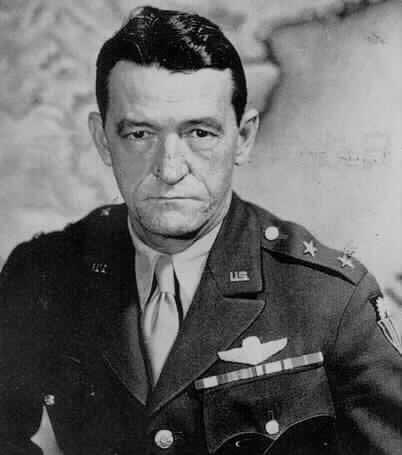Flying Tigers, an enduring sign of fight for peace
china.org.cn / chinagate.cn by Wu Jin, September 9, 2014 Adjust font size:
Almost 70 years after the last cacophonous air raid siren in China was silenced and the Japanese army announced unconditional surrender in World War II, few Chinese may know that their lives were probably saved by a U.S. Lieutenant General who established radio and signal corps in China to alert people of impending bombings.
 |
|
Lieutenant General Claire Lee Chennualt, the late commander of the Flying Tigers. |
Claire Lee Chennault, a U.S. Lieutenant General and the Commander of the famous Flying Tigers American Volunteer Group in China, was the man behind the establishment of China's air defense system during the country's War of Resistance against Japanese Aggression (1938-1945).
On the 69th anniversary of the end of WWII, Nell Calloway, Chennault's granddaughter and the director of the Chennault Aviation and Military Museum in Louisiana, the United States , spoke with China.org.cn through an email interview.
"My grandfather played a vital role in that he was one of the first Americans to respond to China's need," Calloway said. "His accomplishments with the Chinese people laid the framework for what the Tigers would need to be victorious."
Having arrived in China in 1937, Chennault helped the Chinese government establish an air strike alert system and build runways for the fledging Chinese air force.
Despite China's decade of rapid development between 1927 and 1937, the country's national defense and modern armaments were still vulnerable when Japan launched a war against it in 1937. Because of the prevalence of isolationist sentiment in the United States and the war in Europe, China fought almost single-handedly against Japan's atrocious aggression for several years, which claimed millions of innocent lives. It was not until 1941 when the Japanese bombed Pearl Harbor, a U. S. military base that the U.S. government agreed to join hands with China in the anti-Fascist camp. At that time, the well-trained U.S. Air Force formed the Flying Tigers group, which stood side by side with the novice Chinese pilots to combat Japanese air attacks.
In an attempt to surmount the language barrier, the uniform of each U.S. pilot had a Chinese tag sewn to it, which identified each American airman as a friend of the Chinese people and asked local people who spotted pilots who were injured or in need of help to render their assistance.
According to Calloway, Chennault and his Tigers team greatly appreciated the rescue efforts of the local villagers.
"My grandfather was extremely grateful to the local Chinese people who risked their lives to save, recover and return the pilots so they could fly again against the Japanese," Calloway said. "The pilots themselves deeply appreciated the rescue efforts of the villagers, and the American military formed a lasting memory of the friendship and sacrifices of the Chinese people."
Sixty nine years have passed, and the traumatic experience of war has gradually receded from people's memory as the veterans of World War II have passed away one after another. A new generation, who have grown up in peace and prosperity, have few chances to learn about their grandparents' resolution and bravery in fighting in one of the most ferocious wars in the history of mankind. But the history remains as a lesson for us, serving as a warning against allowing the international situation to deteriorate into another global war.
"All history is important to learn from, and the people with no past have no future," said Calloway. "As we approach the 70th anniversary of the end of the war, it is very important that peoples from both countries remember this time of fighting together side by side to change history and give us a brighter future."
Calloway told China.org.cn that she is raising funds to set up a Chennault Institute in Monroe, Louisiana, the Lieutenant General's hometown, where scholars from both China and the United States can come together, not only to learn that shared history, but also to seek a mutual understanding of today's issues.
General Chennault once wrote in his book, "Way of a Fighter," that, "It is my fondest hope that the sign of the Flying Tigers will remain aloft just as long as it needed and that it will always be remembered on both shores of the Pacific as the symbol of two great peoples working towards a common goal in war and peace."


